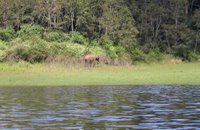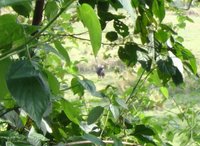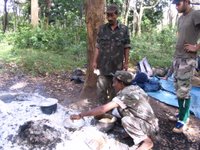Friday, December 09, 2005
Periyar Tiger Reserve

The Periyar Tiger Reserve is an awesome place to visit for countless reasons. If these pictures and this post does not convince you that you just HAVE TO visit this place, feel free to count me among the worst writers of all time!
The sanctuary is located in the western ghat range, over an area of 700+ sq km. It has about 35-40 tigers, as well as herds of elephants, bison, deer, wild boar, 300+ varieties of birds, some of them rare, exotic and
 endangered species.
endangered species.Kerala is India's most educated state, with a 100% literacy rate, and it shows. This is one place where I saw an extraordinary awareness among people about the environment and the need to preserve it. Also, this is one of the few places in India where eco-tourism is a well-organized endeavor and has taken off in a big way.
The Periyar sanctuary is located around the Lake Periyar, an artificial lake created by damming the Periyar river. The lake is surrounded by mountains covered with fairly dense forest. The weather in winter is pleasant, with daytime temperatures in the late 70s/early 80s. At this time of the year (late Nov/early Dec), it's the time for the
 retreating monsoon in South India, so heavy rains usually occur. The time to see animals is usually late evening or early morning, since that's when they emerge from their jungle hideouts to drink water.
retreating monsoon in South India, so heavy rains usually occur. The time to see animals is usually late evening or early morning, since that's when they emerge from their jungle hideouts to drink water.Conservation issues
There are two huge problems the forests in South India face: animal poachers and Sandalwood
 smugglers. Tigers have been poached and hunted mercilessly in India ever since the time of the Raj. The ubiquitous photos in history books of British sahibs in sola hats and Indian maharajas posing over dead tigers/skins serve as disgusting reminders that despicable colonial tradition: the tiger hunt. During the British rule, these regal creatures were mercilessly hunted for pleasure and trophies to within a sliver of extinction. Nowadays, tiger parts are valued for so-called medicinal and aphrodisiac powers, particularly in China. But conservation efforts like Project Tiger are slowly crawling back, although poaching still remains a problem and the tiger is a highly endangered species.
smugglers. Tigers have been poached and hunted mercilessly in India ever since the time of the Raj. The ubiquitous photos in history books of British sahibs in sola hats and Indian maharajas posing over dead tigers/skins serve as disgusting reminders that despicable colonial tradition: the tiger hunt. During the British rule, these regal creatures were mercilessly hunted for pleasure and trophies to within a sliver of extinction. Nowadays, tiger parts are valued for so-called medicinal and aphrodisiac powers, particularly in China. But conservation efforts like Project Tiger are slowly crawling back, although poaching still remains a problem and the tiger is a highly endangered species.Elephants, while not endangered, have been valued and poached for their ivory tusks. This problem too, has been contained to some extent now, and elephants are thriving in most forests.
Sandalwood (chandan) is a rare small tree whose bark and wood give off the famous, intoxicating sandalwood fragrance. Grown chiefly in India, and some in Hawaii, the Indian variety is under serious threat from illegal cutting and smuggling activity. The harvest and use of sandalwood is strictly controlled by the Government, and it is rare and expensive, and in great demand in India for religious rituals and herbal medicines.
Eco-tourism in Periyar - Two days on The Tiger Trail
The work being done to protect the forests and the environmental awareness of the locals was enough to persuade me to throw in my support to this amazing effort by indulging myself in several of their eco-tourism options.
 The Jungle Patrol: This is a night trek held in three different time slots. 7-10pm, 10pm-1am and 1-4am. Each of these treks are with a group (at least two) forest guards armed with flashlights and ancient guns. The trek lets you accompany these guards on their regular nightly patrols as they try to protect the forest against sandalwood smugglers (who operate at night) and also provide an informative first-hand guide to the innards of the forest. An
The Jungle Patrol: This is a night trek held in three different time slots. 7-10pm, 10pm-1am and 1-4am. Each of these treks are with a group (at least two) forest guards armed with flashlights and ancient guns. The trek lets you accompany these guards on their regular nightly patrols as they try to protect the forest against sandalwood smugglers (who operate at night) and also provide an informative first-hand guide to the innards of the forest. Anunforgettable experience to hear a dense forest at midnight and know what the sounds are. An unforgettable experience to see the bright eyes of deer surrounding you in a clearing. Leech-protection socks, flashlights and raincoats are provided. You bring yourself, with good boots and a big sense of adventure. Price: Rs 500 ($11) per person.
The Tiger Trail treks: These are 2-day-1-night or 3-day-2-night treks into the heart of the forests, with primitive camping in the night. It's conducted by the Eco-tourism development association, an organization founded by ex-poachers and smugglers, people with unparelleled knowledge of jungles and animals, and legendary tracking skills. I took the 2-day-1-night trek, and it was something!
 We began the day at around 9am, with a 3-hour hike into the jungles towards our campsite, which was the base for all our hikes over that day and the next. We had two guides with us, and three others who went ahead to the campsite with all the ingredients for a meal. The tourists for this trip
We began the day at around 9am, with a 3-hour hike into the jungles towards our campsite, which was the base for all our hikes over that day and the next. We had two guides with us, and three others who went ahead to the campsite with all the ingredients for a meal. The tourists for this trip included two Swedish guys, besides myself. On our hikes we were pointed out tons and tons of interesting trees, birds, insects and so on. Some rare bird sightings were really cool, including the hornbill (sorry, no pics!). The photos include that of a sambar deer, black Nilgiri langur monkey with baby and a huge tiger spider.
included two Swedish guys, besides myself. On our hikes we were pointed out tons and tons of interesting trees, birds, insects and so on. Some rare bird sightings were really cool, including the hornbill (sorry, no pics!). The photos include that of a sambar deer, black Nilgiri langur monkey with baby and a huge tiger spider. The tiger spider is so named because of its black and yellow markings. The specimen in the picture was about the size of my hand (palm+fingers). I'd have loved to place my hand next to it for comparison, but was unable to convince the spider of my honorable intentions. This spider bites, and a pretty painful and poisonous bite, I hear. One of the Swedish guys was totally phobic of spiders, and we had a good time ribbing him about what he'd prefer finding in his tent at night, a tiger or a tiger spider! Sure enough, he wakes up screaming during the night because of a (harmless) spider crawling over him.
The tiger spider is so named because of its black and yellow markings. The specimen in the picture was about the size of my hand (palm+fingers). I'd have loved to place my hand next to it for comparison, but was unable to convince the spider of my honorable intentions. This spider bites, and a pretty painful and poisonous bite, I hear. One of the Swedish guys was totally phobic of spiders, and we had a good time ribbing him about what he'd prefer finding in his tent at night, a tiger or a tiger spider! Sure enough, he wakes up screaming during the night because of a (harmless) spider crawling over him. During lunch, the guards heard from some of the tribals about an elephant sighting, so we set off crossing the lake on the flimsiest of bamboo rafts. Sure enough, after 15 minutes of vigourous rowing, we see a single elephant, which we dare not approach too close coz single elephants can be very dangerous. But the rafting was an experience too!
During lunch, the guards heard from some of the tribals about an elephant sighting, so we set off crossing the lake on the flimsiest of bamboo rafts. Sure enough, after 15 minutes of vigourous rowing, we see a single elephant, which we dare not approach too close coz single elephants can be very dangerous. But the rafting was an experience too!Later in the afternoon, we struck gold. Well, silver, because gold would have been a tiger sighting. During one of our hikes we almost ran into a little herd of elephants, and a herd of
 bison in the same open clearing! The two female elephants had a baby elephant with them, so they were protective. Our guide lit up a beedi to determine the direction of the wind, as long as the wind blew towards us from the
bison in the same open clearing! The two female elephants had a baby elephant with them, so they were protective. Our guide lit up a beedi to determine the direction of the wind, as long as the wind blew towards us from the  elephants we were good. Then the wind changed, and one of the elephants began to move threateningly in our direction. We just had to hurry out of the area! The bison in the picture was a bit far away, but we got to see it nursing a calf!
elephants we were good. Then the wind changed, and one of the elephants began to move threateningly in our direction. We just had to hurry out of the area! The bison in the picture was a bit far away, but we got to see it nursing a calf!The tigers stayed hidden, perhaps for the better. We did get to see some fresh pugmarks and dung, but little else :( Well, all good for a first-time forest excursion. The night in the tent was dark. It started raining heavily during the night, and let me assure you that the sound of rain in a forest on your flimsy
 tent is one of the most wonderful sounds on the planet! The guards cooked up a feast of a
tent is one of the most wonderful sounds on the planet! The guards cooked up a feast of aveggie meal on a little wood fire, with rice, sambar dal, and 3 different vegetable entrees! They set up a watch at night with a campfire going, and played cards deep into the night. These people made the jungle their home. While we were resting, some of them amused themselves by fishing on our little bamboo rafts.
 I'll just have to say that this was one of my most memorable excursions ever, and has left me with a new appreciation for forests and their wildlife. Definitely not the last time for me in forests!
I'll just have to say that this was one of my most memorable excursions ever, and has left me with a new appreciation for forests and their wildlife. Definitely not the last time for me in forests!
